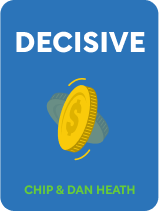

This article is an excerpt from the Shortform book guide to "Decisive" by Chip and Dan Heath. Shortform has the world's best summaries and analyses of books you should be reading.
Like this article? Sign up for a free trial here.
Is it better to limit or expand your options when making decisions? What are the dangers of binary decision-making?
When it comes to decision-making, we tend to come up with only two options. Thinking in binary terms may be less cognitively taxing, but it limits your options and clouds your judgment.
Here are some strategies for overcoming binary decision-making.
How to Come Up With More Options
You can counteract the tendency towards binary decision-making by coming up with more options. Doing so guarantees that you have at least two backup options. However, having too many options overwhelms you. It’s best to aim for three to four strong, distinct options.
In this section, we’ll share strategies for coming up with three to four strong, distinct options.
Strategy 1: Both/And Thinking
Binary choices are between choice A or B, but it’s often better to pursue a both/and option: one that combines the best parts of both A and B. One technique for creating a both/and option is to combine an optimistic choice with a cautious one. According to the authors, a cautiously optimistic option prepares you for a range of outcomes—both positive and negative. It serves as a middle ground between a high-risk option and one that’s too prudent.
For example, imagine a postal worker who’s considering quitting his job to become an artist. Within the binary of “quit or not,” the optimistic option is to quit and hope he can earn a living making art. The cautious option is to continue as a postal worker. A cautiously optimistic option could be to reduce his hours at the post office while he takes time to launch his career as an artist.
(Shortform note: A cautiously optimistic mindset may provide you with general benefits in life, beyond the realm of decision-making. Research in psychology suggests that people who balance optimism with caution experience higher levels of long-term contentment. That said, it might be best to approach some tasks with more optimism than others. For example, some psychologists recommend that you balance caution and optimism when setting goals and then employ a more optimistic mindset when carrying out those plans.)
Strategy 2: Imagine Eliminating Options
Another strategy for developing more options is somewhat counterintuitive: Imagine that one or more of your options have been eliminated. The authors claim that when we rule out an option, we handle this constraint by creatively developing other options.
For example, consider someone who wants to sign up to run a full marathon. However, they’re new to running, and they wonder if they’ll be ready in time. After they imagine eliminating the option of running a full marathon, they research other possibilities. They add “run a half-marathon” to their list. It’s an option that’s both ambitious and realistic.
| Constraints Bolster Creativity Experimental research supports the Heath brothers’ claim that limitations during the creative process drive creative problem-solving. When people are asked to brainstorm ideas without any limits, they follow their intuition instead of innovating. By contrast, when people brainstorm ideas within limits (such as limits on time or money), they tend to generate more creative solutions. What are some additional ways you can apply creativity-inducing constraints while brainstorming options for a decision? Here are three suggestions: Ditch the cellphone. While brainstorming options, keep your cell phone in another room. Research shows that having your cell phone within reach—whether or not you actually use it—limits your cognitive competence. Reduce your online distractions. If you’re looking online for options for a decision, download a website-blocker for your browser so that you don’t waste time web-surfing. Limit the time you spend developing options. Place limits on your brainstorming time so that you don’t waste too much brain power and time generating options you later reject. |
Strategy 3: Learn From Experts
A final way to develop additional options is to learn from experts. The Heaths define an “expert” as anyone who has more experience than you with the topic of your decision. Experts may be able to share tried-and-tested options that you hadn’t even thought of.
For example, consider a teenager who asks his parents for a cell phone. His parents want to please him, but they’re reluctant to increase his social media access. To produce an extra option beyond the binary of “phone or no phone,” they could seek advice from other parents who’ve bought their children cell phones about how to supervise and limit children’s social media use.
(Shortform note: When seeking expert advice for a career-related decision, think carefully about whom to consult and what questions to ask. Researchers suggest that for career-related decisions, you should seek the advice of expert professionals. For personal decisions, seek the advice of experienced friends or family. When approaching an expert for career-related advice, it may help to use informational interview techniques (when you ask questions of someone in a field you’re interested in). Use an email template when reaching out, research the expert in advance, and keep your Q&A short.)

———End of Preview———
Like what you just read? Read the rest of the world's best book summary and analysis of Chip and Dan Heath's "Decisive" at Shortform.
Here's what you'll find in our full Decisive summary:
- Why our minds are wired to make bad decisions
- How biases and cognitive flaws distort your thinking
- A four-step process to improve your decision-making






